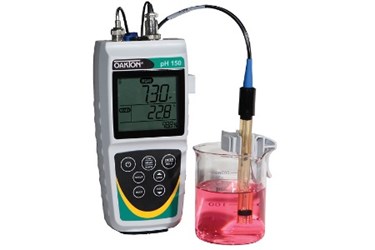Testing Wastewater Using A pH Meter

Excessive pH levels, particulates, and contaminants are typically found in wastewater. Using pH in wastewater treatment requires an accurate and robust measurement with a pH meter. It also necessitates the measurement of the waters temperature.
Because chemical and particulate contamination in wastewater can destroy standard pH electrodes, prematurely killing the junction, specialised pH electrodes are recommended. A double junction electrode will block chemical interferences in the wastewater, and prevent common chemical damages to the reference junction. A flushable junction will handle chemical and particulates in the wastewater easily. A flushable junction is ideal for sludge, paper-pulp, and dirty samples as the easy-to-clean junction never clogs.
Testing the pH of a Wastewater Sample
What’s Needed: A standard pH meter, a durable pH electrode, an automatic temperature compensation (ATC) probe, a stirrer with stir bar, 100-mL graduated cylinder, 100-mL beaker, deionized water and buffers. The pH electrode will be exposed to chemical contaminates and particulates, so a double junction electrode is recommended or, for very dirty samples, a flushable junction electrode.
Sampling: Grab two to three samples from each site into a sealed container. Grab samples of wastewater will off-gas the volatile materials that are present, which could alter the pH level of the sample. Therefore, samples must be collected into a sealed container. Time delays between grabbing the sample and measuring the pH value should be avoided. No sample preservative or preparation required.
Laboratory Testing
- We recommend a 2-point calibration with a pH 4 and a pH 7 buffer solution for more acidic waste and a pH 7 and a pH 10 buffer solution for more basic waste. The electrode slope should be between 92 and 102%.
- Just before testing, use a graduated cylinder to measure 60 mL of the wastewater sample into a 100 mL beaker. Stir the sample. (Note: Allowing wastewater samples with a pH greater than 7 to be exposed to carbon dioxide (CO2 ) in the atmosphere can result in the formation of carbonic acid, which will lower the sample’s pH value—so minimise exposure to the air.)
- Rinse electrode and ATC probe with DI water and blot dry. Place probes in the wastewater sample and allow the measurement to stabilize.
- Record pH measurement. Rinse probes and repeat steps 2 to 4.
Results
A minor (<±0.5 pH) difference between results of the same wastewater sample indicates good technique and high confidence in results.
Source: John Morris Scientific
